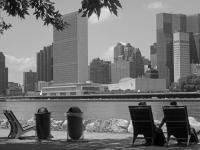Villa Jian Art Museum
Yantai, China
The concept of Villa Jian came from the Chinese local architecture term called “Jian”. In the local architecture culture, there was one commonly used for building space base unit that is "Jian", one "Jian" represented a width of about 3.3 m to 3.6 m of spatial scale, this word "Jian” not only represented a space base unit, but also strongly linked with the local traditional form of construction. Before going further to the development of the design, the client‘s requirement was to build 11 “Jian”. Thus, there was a given condition of designing a big house with a double-slope roof covering 11 “jian”. According to the needs of the client, the building consisted of main two basic functions: office space and exhibition space, both of the functions were limited to a semi-open private property. The starting point was how to combine the semi-open exhibition space with a semi-closed office space under a single roof. The idea was finally to divide both the exhibition and the office into two parts: public exhibition and private exhibition, public office and private office. Public exhibition and office space were placed in the first floor, and the private exhibition and private office were placed in the second floor. Therefore, the entrance was designed to be a semi-open exhibition space, while the other side on the first floor was proposed to be the staff offices. On the second floor, just opposite to the first floor, above the entrance of the first floor were a private parlor and a private office, and the other part was a private exhibition hall. The entire function spaces have become an X-form in the section; the center position of the X has become the hub of linking two functions and two stories. Here wide stair steps were designed for seating as well where the semi-open exhibition space and the semi-closed office space have dramatically been intersected together. This stair hall, as a mixed space, had not only a circulation function but also a dual function for the exhibition performances and the meeting space. Thus, a mixed space system linking different regular functions was the core concept of the building.















